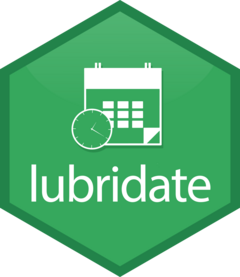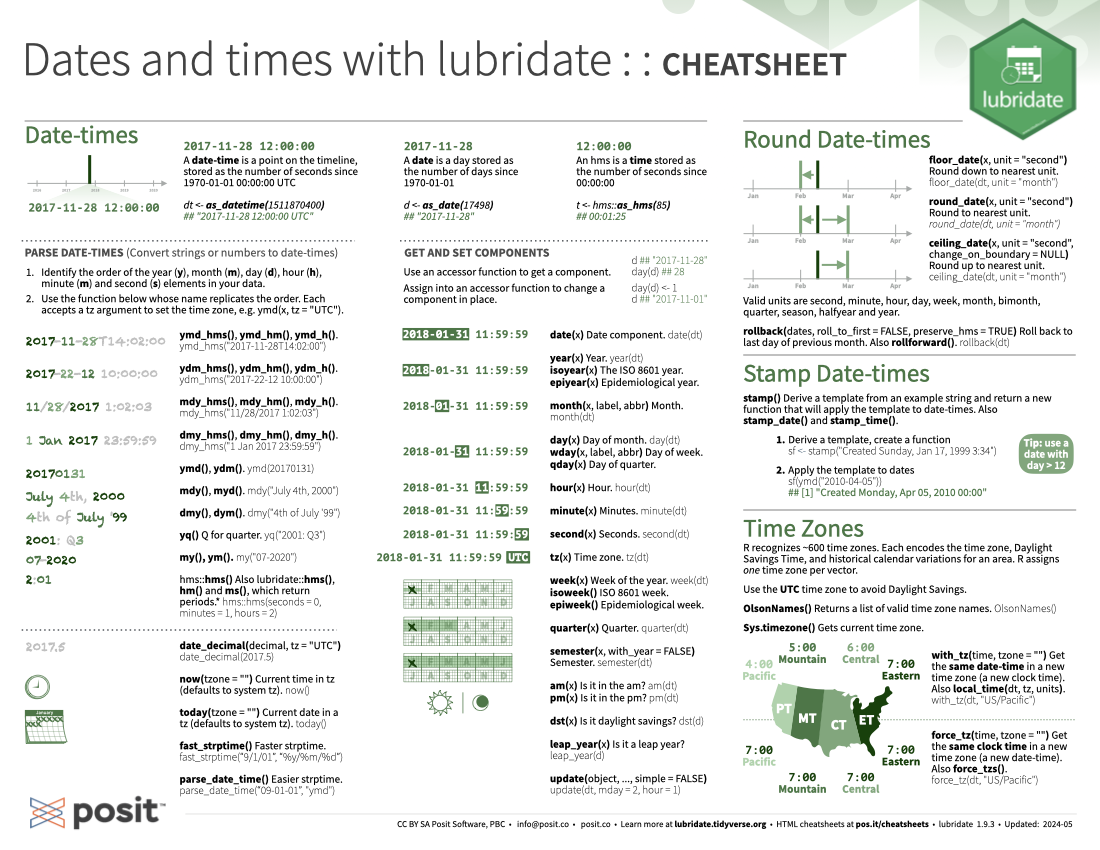
Download PDF

Translations (PDF)
A date-time is a point on the timeline, stored as the number of seconds since 1970-01-01 00:00:00 UTC
A date is a day stored as the number of days since 1970-01-01
An hms is a time stored as the number of seconds since 00:00:00
Convert strings or numbers to date-times
Identify the order of the year (y), month (m), day (d), hour (h), minute (m) and second (s) elements in your data.
Use the function below whose name replicates the order. Each accepts a tz argument to set the time zone, e.g. ymd(x, tz = "UTC").
ymd_hms(), ymd_hm(), ymd_h()
ydm_hms(), ydm_hm(), ydm_h()
mdy_hms(), mdy_hm(), mdy_h()
dmy_hms(), dmy_hm(), dmy_h()
ymd(), ydm()
mdy(), myd()
dmy(), dym()
yq(): Q for quarter.
my(), ym()
hms::hms(): Also lubridate::hms(), hm(), and ms(), which return periods*.
date_decimal(decimal, tz = "UTC")
now(tzone = ""): Current time in tz (defaults to system tz).
today(tzone = ""): Current date in a tz (defaults to system tz).
fast_strptime(): Faster strptime.
parse_date_time(): Easier strptime.
Use an accessor function to get a component.
Assign into an accessor function to change a component in place.
date(x): Date component.
year(x): Year.
isoyear(x): The ISO 8601 year.
epiyear(x): Epidemiological year.
month(x, label, abbr): Month.
day(x): Day of the month.
wday(x, label, abbr): Day of week.
qday(x): Day of quarter.
hour(x): Hour.
minute(x): Minutes.
second(x): Seconds.
tz(x): Time zone.
week(x): Week of the year.
isoweek(): ISO 8601 week.
epiweek(): Epidemiological week.
quarter(x): Quarter.
semester(x, with_year = FALSE): Semester.
am(x): Is it in the am?
pm(x): Is it in the pm?
dst(x): Is it daylight savings?
leap_year(x): Is it a leap year?
update(object, ..., simple = FALSE)
floor_date(x, unit = "second"): Round down to nearest unit.
round_date(x, unit = "second"): Round to nearest unit.
ceiling_date(x, unit = "second"): Round up to the nearest unit.
Valid units are second, minute, hour, day, week, month, bimonth, quarter, season, halfyear and year.
rollback(dates, roll_to_first = FALSE, preserve_hms = TRUE): Roll back to last day of previous month. Also rollforward().
stamp(): Derive a template from an example string and return a new function that will apply the template to date-times. Also stamp_date() and stamp_time().
Derive a template, create a function
Apply the template to dates
Tip: use a date with day > 12
R recognizes ~600 time zones. Each encodes the time zone, Daylight Savings Time, and historical calendar variations for an area. R assigns one time zone per vector.
Use the UTC time zone to avoid Daylight Savings.
OlsonNames(): Returns a list of valid time zone names.
Sys.timezone(): Gets current time zone.
with_tz(time, tzone = ""): Get the same date-time in a new time zone (a new clock time). Also local_time(dt, tz, units). For example, 4:00 Pacific becomes 5:00 Mountain, or 6:00 Central, or 7:00 Eastern.
force_tz(time, tzone = ""): Get the same clock time in a new time zone (a new date-time). Also force_tzs(). For example, 7:00 Pacific becomes 7:00 Mountain, or 7:00 Central, or 7:00 Eastern.
Lubridate provides three classes of timespans to facilitate math with dates and date-times.
Math with date-times relies on the timeline, which behaves inconsistently. Consider how the timeline behaves during:
Periods track changes in clock times, which ignore time line irregularities.
Durations track the passage of physical time, which deviates from clock time when irregularities occur.
Intervals represent specific intervals of the timeline, bounded by start and end date-times.
Not all years are 365 days due to leap days. Not all minutes are 60 seconds due to leap seconds. It is possible to create an imaginary date by adding months, e.g. February 31st.
%m+% and %m-% will roll imaginary dates to the last day of the previous month.
add_with_rollback(e1, e2, roll_to_first = TRUE) will roll imaginary dates to the first day of the new month.
Add or subtract periods to model events that happen at specific clock times, like the NYSE opening bell.
Make a period with the name of a time unit pluralized, e.g.
[1] "3m 12d 0H 0M 0S"years(x = 1): x years.
months(x = 1): x months.
weeks(x = 1): x weeks.
days(x = 1): x days.
hours(x = 1): x hours.
minutes(x = 1): x minutes.
seconds(x = 1): x seconds.
milliseconds(x = 1): x milliseconds.
microseconds(x = 1): x microseconds.
nanoseconds(x = 1): x nanoseconds.
picoseconds(x = 1): x picoseconds.
period(num = NULL, units = "second", ...): An automation friendly period constructor.
as.period(x, unit): Coerce a timespan to a period, optionally in the specified units. Also is.period().
period_to_seconds(x): Convert a period to the “standard” number of seconds implied by the period. Also seconds_to_period().
Add or subtract durations to model physical processes, like battery life. Durations are stored as seconds, the only time unit with a consistent length. Difftimes are a class of durations found in base R.
Make a duration with the name of a period prefixed with a d, e.g.
[1] "1209600s (~2 weeks)"dyears(x = 1): 31536000x seconds.
dmonths(x = 1): 2629800x seconds.
dweeks(x = 1): 604800x seconds.
ddays(x = 1): 86400x seconds.
dhours(x = 1): 3600x seconds.
dminutes(x = 1): 60x seconds.
dseconds(x = 1): x seconds.
dmilliseconds(x = 1): x * 10-3 seconds.
dmicroseconds(x = 1): x * 10-6 seconds.
dnanoseconds(x = 1): x * 10-9 seconds.
dpicoseconds(x = 1): x * 10-12 seconds.
duration(num = NULL, units = "second", ...): An automation friendly duration constructor.
as.duration(x, ...): Coerce a timespan to a duration. Also is.duration(), is.difftime().
make_difftime(x): Make diffime with the specified number of units.
Divide an interval by a duration to determine its physical length, divide by an interval by a period to determine its implied length in clock time.
Make an interval with interval() or %--%, e.g.
[1] 2017-01-01 UTC--2017-11-01 UTC[1] 2017-11-01 UTC--2017-12-31 UTCa %within% b: Does interval or dte0time a fall within interval b?
int_start(int): Access/set the start date-time of an interval. Also int_end().
int_aligns(int1, int2): Do two intervals share a boundary? Also int_overlaps().
int_diff(times): Make the intervals that occur between the date-times in a vector.
int_flip(int): Reverse the direction of an interval. Also int_standardize().
int_length(int): Length in seconds.
int_shift(int, by): Shifts an interval up or down the timeline by a timespan.
as.interval(x, start, ...): Coerce a timespan to an interval with the start date-time. Also is.interval().
CC BY SA Posit Software, PBC • info@posit.co • posit.co
Learn more at lubridate.tidyverse.org.
Updated: 2024-05.